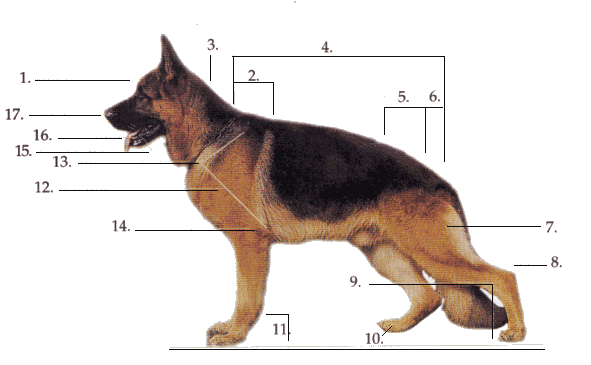The site was last updated on
24 Aug 2000
|
Name of breed: German
Shepherd Dog
Class: Herding
Size: Height at top of shoulders: dogs 60-65 cm (24-26 in)
bitches 55-60 cm (22-24 in)
Weight: about 33.7-42.7kg (75-95lb)
Coat: Medium length,
straight, hard and close-lying, with a
dense, thick undercoat.
Colors: Solid black or
Grey; black
saddle with tan or gold to light Grey markings; Grey with lighter or brown markings
(referred to as . Blues, livers, albinos and whites highly undesirable (a
light-coated German Shepherd is included in the breed standards of some overseas
.
It has
suggested that the German Shepherd Dog (Alstain or Deutscher Schaferhund) may be a
descendant of the Bronze Age wolf. Certainly, around the 7th century AD, there existed in
Germany a shepherd dog of similar type but with a lighter coat. /by the 16th century, the
coat isaid to have darkned appreciably.The German Shepherd was first exhibited at a dog show in Hanover in 1882. Credit for the formation of the modern breed is generally attributed to the German fancier, Rittmeister von Stephanitz, who worked tirelessly in the early 1900s to improve its temperament and conformation. The breed won dedicated fanciers in other countries, including Britain and America, among those who had seen the breed working in Germany in the First World War. It was at that time thought inappropriate to call the breed by a name that included the word "German", and it became known in the United Kingdom, and elsewhere, as the Alsatian because it had originated in the Alsace. In 1971, the British Kennel Club finally relented and the name German Shepherd Dog was restored. Character and care
The popular German Shepherd is extremely intelligent and makes a first-class companion, show dog, obedience worker and guard. It is eminently trainable and so works as a police dog, in the armed services, as a guide dog for the blind, and in numerous other capacities. It needs vigorous daily grooming, plenty of exercise and, above all, a job to do, even if only entails competing in obedience or Agility tests. It is unfair and unwise for this intelligent animal to be subjected a life of boredom.
| 1. Stop | 7. Upper thigh | 13. Higher part of front angle |
| 2. Length of withers | 8. Hock | 14. Elbow |
| 3. Neck | 9. Back angle - should be at 90* | 15. Dewlap |
| 4. Length of Back | 10. Paws- should be as a "Cat grip" and not flat | 16. Muzzle (tong) |
| 5. Loin | 11. Front angle | 17. Upper muzzle (nose) |
| 6. Croup | 12. Lower part of front angle |
